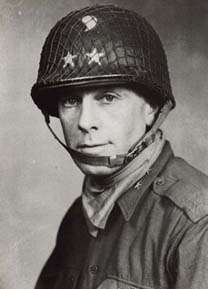Charles H. Gerhardt
| Charles Hunter Gerhardt | |
|---|---|
 Major General Charles Gerhardt | |
| Born | June 6, 1895 |
| Died | October 9, 1976 (aged 81) |
| Buried at | Arlington National Cemetery, Virginia |
| Allegiance |
|
| Service/branch |
|
| Rank |
|
| Commands held |
91st Infantry Division 29th Infantry Division |
| Battles/wars | |
| Awards |
Distinguished Service Medal Silver Star Legion of Merit Bronze Star Medal (2) |
Major General Charles Hunter Gerhardt (June 6, 1895 – October 9, 1976) commanded the U.S. 29th Infantry Division from 1943 until the end of World War II and during part of the occupation of Germany. The division's most famous combat operations were the Omaha Beach landings of June 6, 1944 (his 49th birthday), D-Day and the taking of the French crossroads town of Saint-Lô in July 1944.
Early life
Gerhardt grew up in the Army as the son of a career officer who retired as a brigadier general. The younger Gerhardt attended the United States Military Academy at West Point where he earned a reputation as a skilled football, baseball and polo player. In 1916, Gerhardt quarterbacked West Point to a 30-10 upset win over Notre Dame, which was led by the famed freshman George Gipp. It was Notre Dame's only loss that year.
Military career
Upon graduation Gerhardt was commissioned a Second Lieutenant of Cavalry and served during World War I with the 89th Division. In 1932, Gerhardt was selected as a judge in the equestrian events for the 1932 Olympic Games held in Los Angeles, CA. His senior command prior to leading the 29th Infantry Division was as the commanding general of the 91st Infantry Division at Camp White, Oregon.
Gerhardt was a hard taskmaster, strict disciplinarian and considered by many of his men to be a martinet, who often became upset at small things such as a soldier not having the chinstrap of his helmet buckled. One famous story has him admonishing a soldier on the day after D-Day for dropping peels from the orange he was eating on the ground. He was intolerant of any dirt or mud being on the trucks, and would make soldiers stop and clean a truck under almost any circumstance. Gerhardt was, however, a superb and driven trainer of soldiers and expected the same from his subordinates.
Gerhardt was also one of the European Theater's more controversial generals. His critics held that he was lacking as a military tactician and careless with the lives of his men; often pointing to the astonishingly high casualty rate of the 29th Division. It was said that Gerhardt actually commanded three divisions: one on the field of battle, one in the hospital and one in the cemetery. He was also considered somewhat loose morally, as evidenced by a house of prostitution he established for his men near Rennes, France, which General Omar N. Bradley did not approve of and ordered closed. Gerhardt usually walked the line between approval and disapproval with his superior officers. After the war, he was demoted to Colonel for reasons thought to be a combination of the 29th Division's high casualty rate and his moral lapses.
Later life
Following World War II Gerhardt served as the United States Defense Attaché to Brazil and in a post at Fort Meade, Maryland. He reattained the rank of brigadier general and was able to retire at his highest held rank of major general. He is buried at Arlington National Cemetery.
See also
Further reading
- Beyond the Beachhead: The 29th Division in Normandy, by Joseph Balkoski
- 29 Let's Go! A History of the 29th Infantry Division in World War II, by Joseph Ewing
External links
- Memoirs of Charles H. Gerhardt, Dwight D. Eisenhower Presidential Library
- 29th Division order of battle at Omaha Beach
- Gerhardt biography at www.arlingtoncemetery.net
- Booklet of the 29th Infantry Division
| Military offices | ||
|---|---|---|
| Preceded by Major General Leonard T. Gerow |
Commanding General of the 29th Infantry Division 1943 – 1946 |
Succeeded by Division inactivated |
|